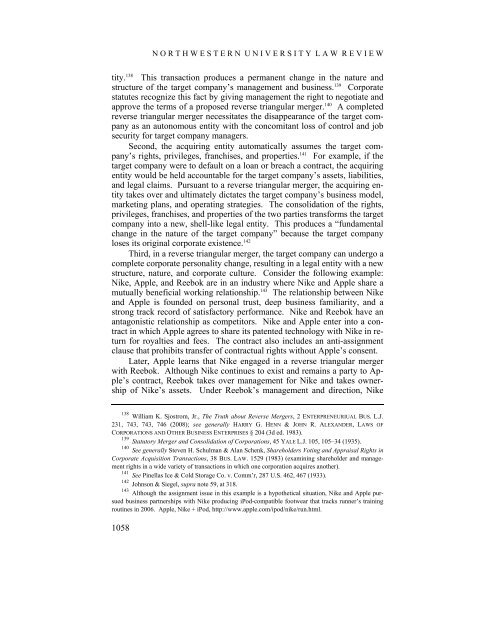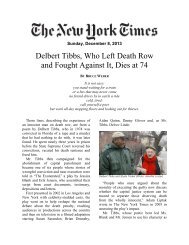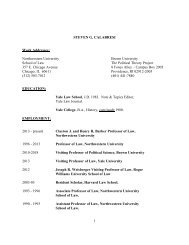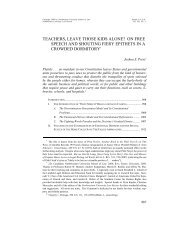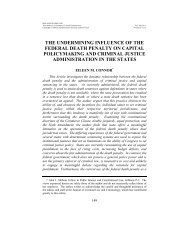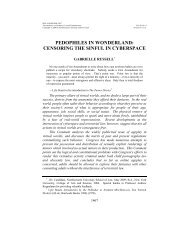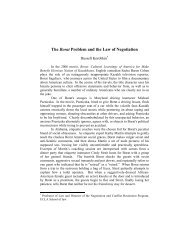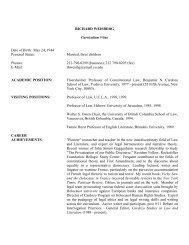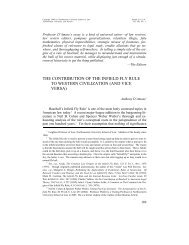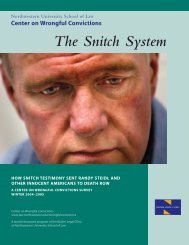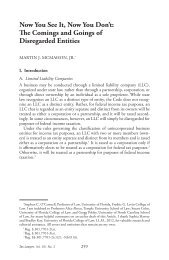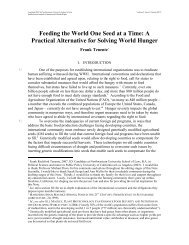The Reverse Triangular Merger Loophole and Enforcing Anti
The Reverse Triangular Merger Loophole and Enforcing Anti
The Reverse Triangular Merger Loophole and Enforcing Anti
You also want an ePaper? Increase the reach of your titles
YUMPU automatically turns print PDFs into web optimized ePapers that Google loves.
1058<br />
N O R T H W E S T E R N U N I V E R S I T Y L A W R E V I E W<br />
tity. 138 This transaction produces a permanent change in the nature <strong>and</strong><br />
structure of the target company’s management <strong>and</strong> business. 139 Corporate<br />
statutes recognize this fact by giving management the right to negotiate <strong>and</strong><br />
approve the terms of a proposed reverse triangular merger. 140 A completed<br />
reverse triangular merger necessitates the disappearance of the target company<br />
as an autonomous entity with the concomitant loss of control <strong>and</strong> job<br />
security for target company managers.<br />
Second, the acquiring entity automatically assumes the target company’s<br />
rights, privileges, franchises, <strong>and</strong> properties. 141 For example, if the<br />
target company were to default on a loan or breach a contract, the acquiring<br />
entity would be held accountable for the target company’s assets, liabilities,<br />
<strong>and</strong> legal claims. Pursuant to a reverse triangular merger, the acquiring entity<br />
takes over <strong>and</strong> ultimately dictates the target company’s business model,<br />
marketing plans, <strong>and</strong> operating strategies. <strong>The</strong> consolidation of the rights,<br />
privileges, franchises, <strong>and</strong> properties of the two parties transforms the target<br />
company into a new, shell-like legal entity. This produces a “fundamental<br />
change in the nature of the target company” because the target company<br />
loses its original corporate existence. 142<br />
Third, in a reverse triangular merger, the target company can undergo a<br />
complete corporate personality change, resulting in a legal entity with a new<br />
structure, nature, <strong>and</strong> corporate culture. Consider the following example:<br />
Nike, Apple, <strong>and</strong> Reebok are in an industry where Nike <strong>and</strong> Apple share a<br />
mutually beneficial working relationship. 143 <strong>The</strong> relationship between Nike<br />
<strong>and</strong> Apple is founded on personal trust, deep business familiarity, <strong>and</strong> a<br />
strong track record of satisfactory performance. Nike <strong>and</strong> Reebok have an<br />
antagonistic relationship as competitors. Nike <strong>and</strong> Apple enter into a contract<br />
in which Apple agrees to share its patented technology with Nike in return<br />
for royalties <strong>and</strong> fees. <strong>The</strong> contract also includes an anti-assignment<br />
clause that prohibits transfer of contractual rights without Apple’s consent.<br />
Later, Apple learns that Nike engaged in a reverse triangular merger<br />
with Reebok. Although Nike continues to exist <strong>and</strong> remains a party to Apple’s<br />
contract, Reebok takes over management for Nike <strong>and</strong> takes ownership<br />
of Nike’s assets. Under Reebok’s management <strong>and</strong> direction, Nike<br />
138<br />
William K. Sjostrom, Jr., <strong>The</strong> Truth about <strong>Reverse</strong> <strong>Merger</strong>s, 2 ENTERPRENEURIUAL BUS. L.J.<br />
231, 743, 743, 746 (2008); see generally HARRY G. HENN & JOHN R. ALEXANDER, LAWS OF<br />
CORPORATIONS AND OTHER BUSINESS ENTERPRISES § 204 (3d ed. 1983).<br />
139<br />
Statutory <strong>Merger</strong> <strong>and</strong> Consolidation of Corporations, 45 YALE L.J. 105, 105–34 (1935).<br />
140<br />
See generally Steven H. Schulman & Alan Schenk, Shareholders Voting <strong>and</strong> Appraisal Rights in<br />
Corporate Acquisition Transactions, 38 BUS. LAW. 1529 (1983) (examining shareholder <strong>and</strong> management<br />
rights in a wide variety of transactions in which one corporation acquires another).<br />
141<br />
See Pinellas Ice & Cold Storage Co. v. Comm’r, 287 U.S. 462, 467 (1933).<br />
142<br />
Johnson & Siegel, supra note 59, at 318.<br />
143<br />
Although the assignment issue in this example is a hypothetical situation, Nike <strong>and</strong> Apple pursued<br />
business partnerships with Nike producing iPod-compatible footwear that tracks runner’s training<br />
routines in 2006. Apple, Nike + iPod, http://www.apple.com/ipod/nike/run.html.


